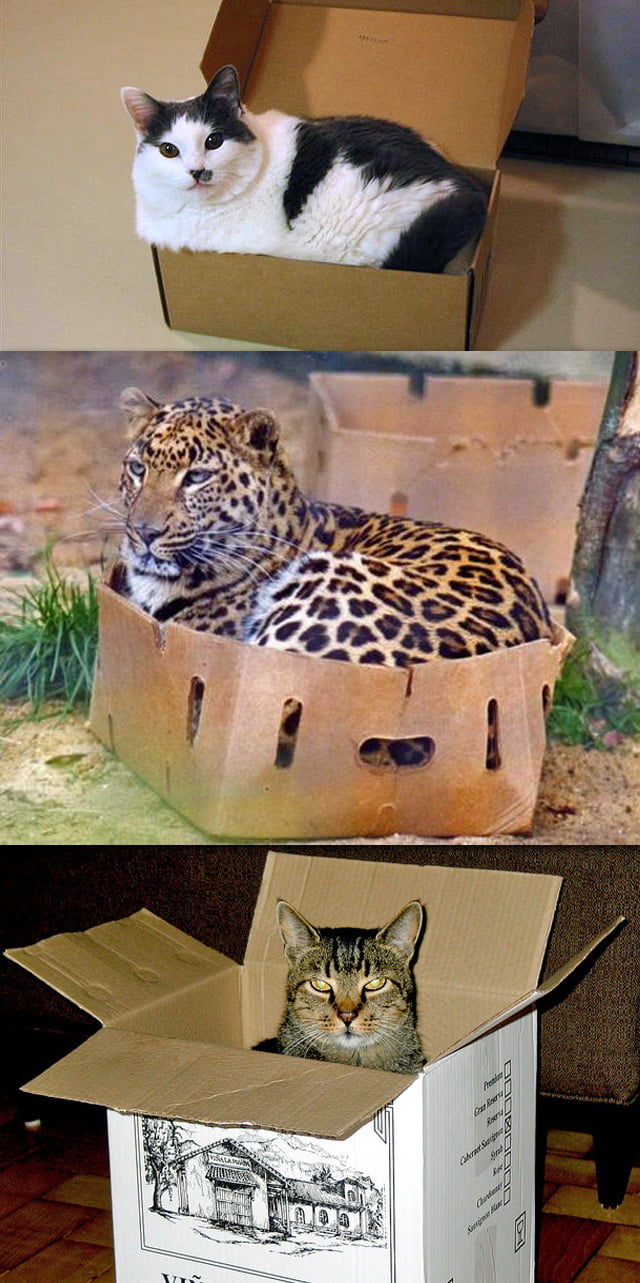The humble, yet extremely useful, cardboard box proves that the essence of the cat resides in all cats; wild to domestic. They like to sit inside them. It makes them feel comfortable. That has to be reason for the domestic cats attraction to the cardboard box. Often, small boxes are preferred; boxes that the cat can hardly get into. A smaller box probably provides both support and a sense of security while cardboard is warm and an insulator. The attraction appears to be about that eternal truth: animals, including humans, migrate towards a comfort zone of whatever type.

My thanks to dw for spotting the picture of the wild cat inside the box.
Now the question is what species is the cat? It is a leopard in my opinion. The only other species that it could be is a jaguar. They are very similar but the spots are different.
I have said it before, the domestic cat is still 99% like a wild cat species and it does not matter how large or small the wild cat is. Maru, the Japanese bicolor tabby, is the most famous box-lover. Perhaps the connection between domestic and wild cat is fading because of domestication?
I have to quote Mel and Fiona Sunquist from their excellent book Wild Cats Of The World:
“When you have a cat in your home, you live with the essence of a tiger….[domestic cats] are a whisker away from their wild relatives…”
Boxes prove this…


Thanks Rudolph, I’ll do this now.
Hello Michael,
I have posted the photos on the “Wild cat V/s Macaque monkeys encounter in Shimla.Hope you received it.I have made the video and you can check it on “Youtube”.
Hi Rudolph, nice to hear from you again. Your story is very interesting. I’d love you to email me the photos. You have my email address. Please email them to me and I’ll do an article about the experience. The cat you saw could only be one of two: leopard cat or rusty-spotted cat (world’s smallest cat). Both their known ranges are no longer in the area of Shimla. However, the experts get the ranges (distribution) of the wild cats wrong sometimes.
It is probably a leopard cat as they are less rare and adaptable. They have learnt to live on plantations.
Good Morning Mr Michael.Broad and nice to read “Pictures of Cats” after a gap of 15 days, the duration of my tour of North India.Just returned on Friday(15-3-2013) and have been lucky to record and photograph a unique Indian wild cat encounter with Macaque monkeys and crows in the hill-station city of Shimla,once the Summer capital of the British Empire in India.As i was strolling on a early morning walk along the main street of Shimla leading to the “Mall” heard a dog barking , having climbed a short tree.At first i thought it had chased a monkey up the tree but on scrutinisation from my binoculars was surprised to find a small cat perched on the top branch.This wild cat which is grey in colour and a small face like a kitten is rare and endangered in India, most of its habitat being lost to human forest clearing which includes the beautiful city of Shimla.The dog later gave up the cjase, the cat having climbed the top most branch of a the tree , later to be harassed by a pair of monkeys and jungle crows. I filmed the entire proceeding on my amateur camera and would like readers of your site to view the same, although not as good as a “National Geographic” documentary. I was just lucky to be at the “RIGHT PLACE AT THE RIGHT TIME”. I hope the cat escaped its tormentors for it was still crouching on the top-most last branch of the tree being constantly watched by the monkeys with crows crowing.I left the place as i had other sight-seeing places to visit, sincerely hoping that this rare and elusive wild-cat escaped its tormentors.Sorry to brag,but, any wild-life professional photographer or documentary film-maker would envy being in my place to photograph and experience this rare wild-life natural encounter.
Heh! Tootsie is an aberration. She is not at all interested in entering cardboard boxes, or enclosed spaces of any kind.
The only exception is a cardboard thingy with low sides. I bought that in preparation for adopting her, and put it on top of the tallest piece of furniture in my bedroom, something like a “wardrobe” as I believe you Brits call it. Her route to access is- jump from bed, or short cat tower, or floor to the top of the chest of drawers (about 2′ 6″ tall) and then to the top of the “wardrobe” (another 3′). She then curls up in the cardboard thingy, and naps contentedly, high up in the room.